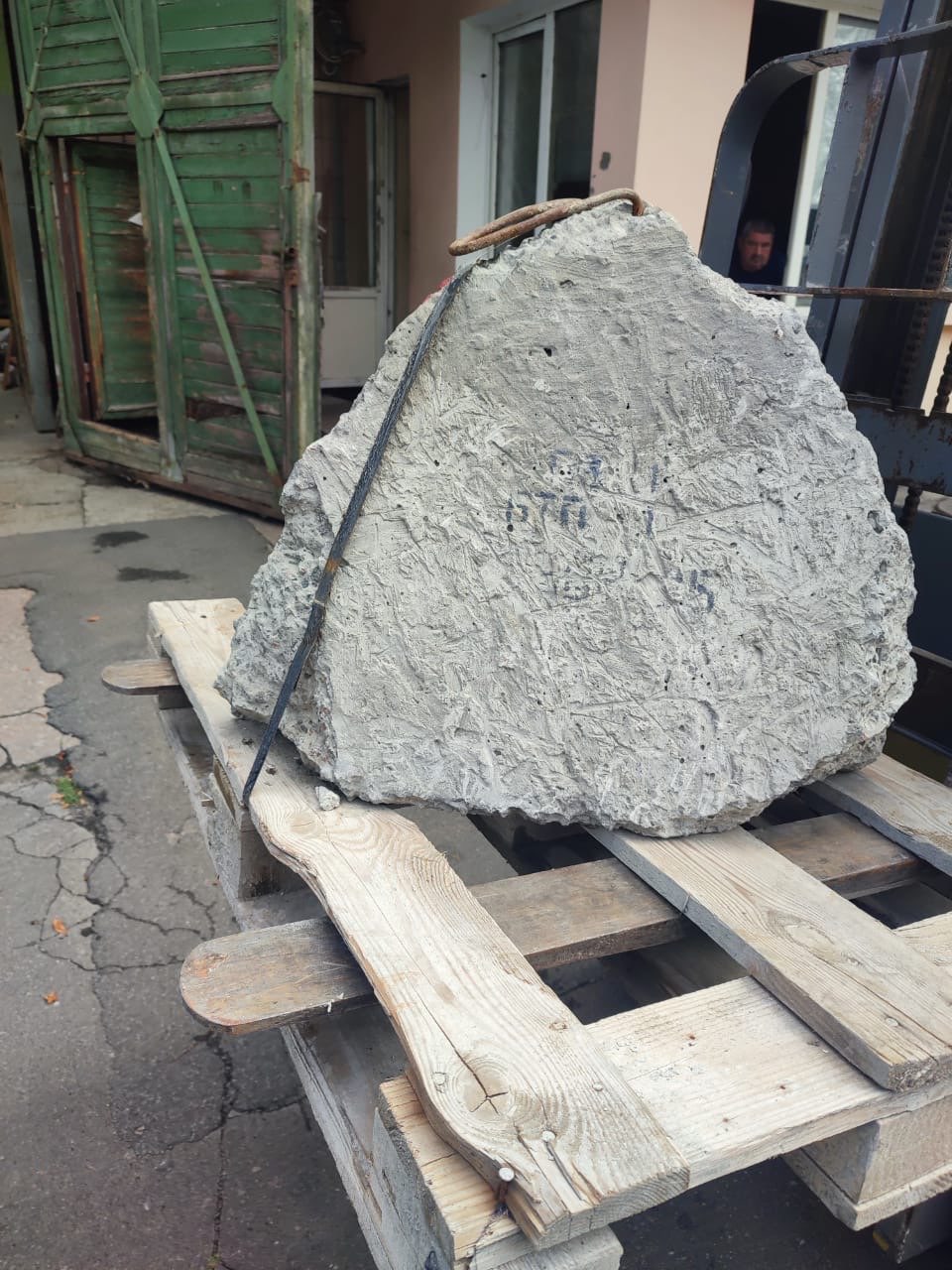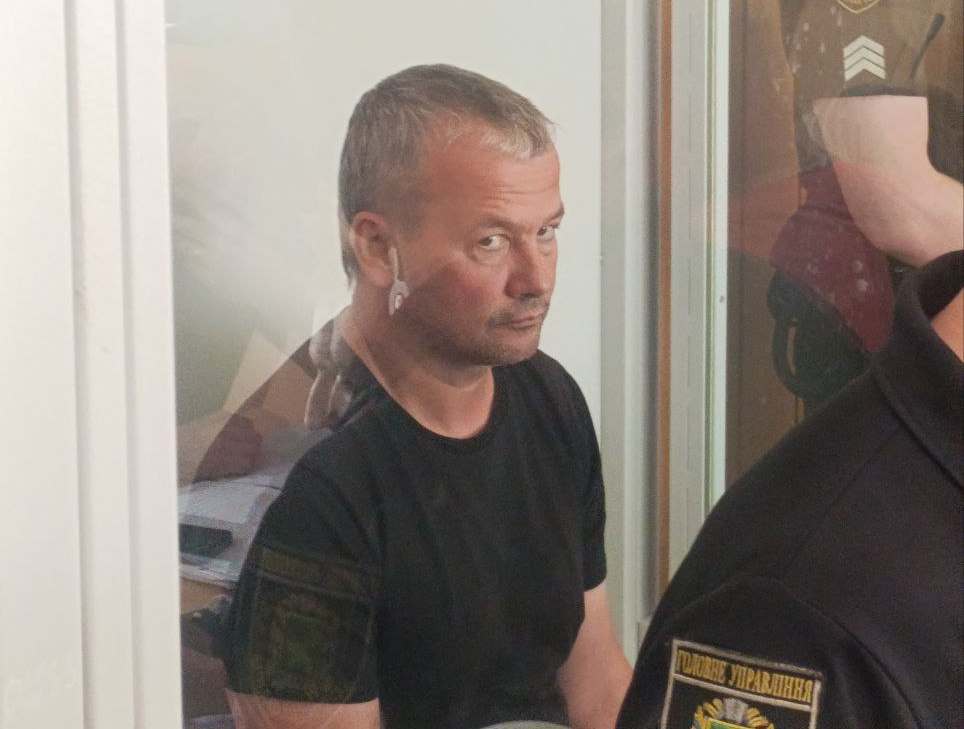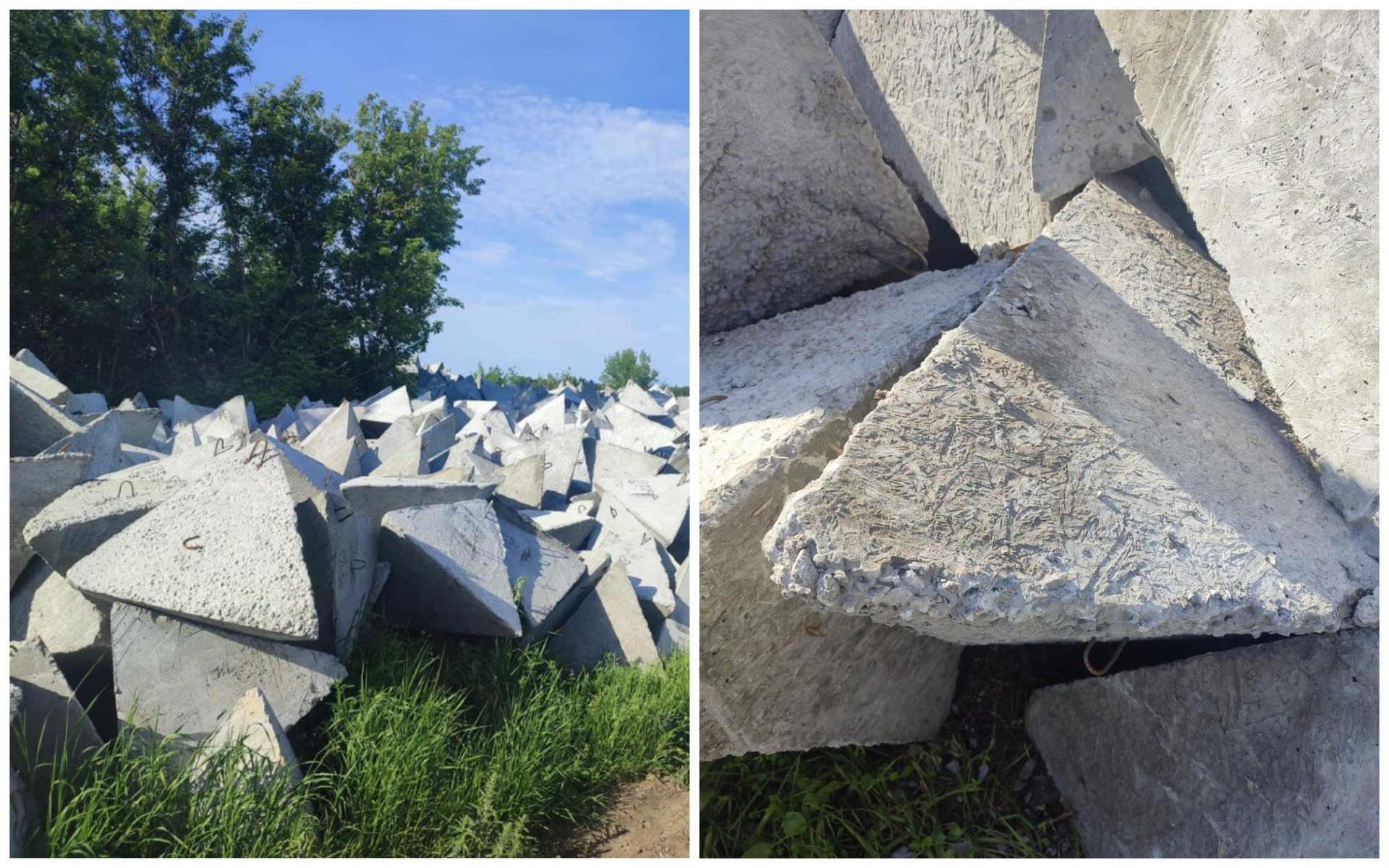Anti-tank ditch, a mine field, cement tetrahedra (or defensive pyramids), barbed wire, and another mine field. This is how a typical artificial obstacle looks like, which is meant to contain the attack of the enemy’s reinforced machinery. Each element of this construction has its own significance. One of the relevant components of this system is believed to be cement pyramids, often referred to as “dragon’s teeth” due to their specific form. These are the pyramids we are going to talk about.
The fortifications are built by the State Transport Special Service, which is a part of the system of the Ministry of Defence, the servicemen-engineers of the Armed Forces of Ukraine (AFU), regional military administrations, and the government-run State Agency for Restoration and Development of Infrastructure. The military structures build defensive constructions closer to the frontline, the first and second lines of defence, and the third line is arranged by the civil ones, respectively.
They all need someone to manufacture the required elements of these obstacles, so they sign agreements with private suppliers. These agreements are not always posted in the system of electronic tenders, Prozorro, for safety reasons. Therefore, it is extremely hard to detect the problematic issues. Yet, periodically, both journalists and law enforcement bodies succeed in finding information about the misuse in these procurements: excessive payments, suspicious contractors, and other trespasses regarding the state finances. We have detected a problem, related not to the money, although this is an issue too, but instead to the goods, supplied to contain the enemy.
NGL.media examined a batch of cement pyramids, intended for the fortifications. And we have all the grounds to believe that the contractor fobbed off some low-quality goods to the AFU, but the experts from the Ministry of Defence didn’t notice it.
Low-quality pyramids
In the summer of 2025, the editorial office of NGL.media was contacted by Colonel Oleksandr P., a former employee of the department of engineer equipment development in the engineering troops We don’t disclose the surname of our interlocutor at his request. The editorial office verified his person and position. He told us about serious problems with the quality of pyramids, supplied to the Kharkiv direction. In the Colonel’s words, he tried to solve this problem without any publicity, but nothing changed, so he dared to go public.
“In June 2025, I was checking our warehouses in different directions. One warehouse, situated in the Kharkiv region, had about 10 thousand defensive pyramids, a considerable part of which looked bad and had questionable quality: they looked too small, had numerous chipped spots and corners. I asked the manager of this warehouse to write a report about the inadequate state of these pyramids, which he did,” Oleksandr said.
The pyramids for this warehouse were supplied by the Kharkiv company, “Bud-Tekhprom”. The relevant agreement with this company was signed by the engineer division of the engineering troops of the Command of the Supporting forces of the AFU, where Oleksandr had served. The agreement, which NGL.media has at hand, states that this company has supplied 50 thousand defensive pyramids to the military unit of the Ministry of Defence for a total of UAH 64.7 mln the cost includes the VAT. Some pyramids were used for fortifications, and the rest were kept in the warehouse.
In Oleksandr’s words, after the warehouse manager reported to the commanders about the inadequate look of the pyramids, the representatives of the Supporting forces of the AFU conducted audits in this and other warehouses where dragon’s teeth were kept, but they didn’t find any significant problems.
“There were some questions about the sizes of pyramids, produced by “Bud-Tekhprom”, but no considerable deviations were detected. Along with this official audit, I decided to conduct an unofficial one to personally make sure that there really were no problems. I had a private institution examine one of these pyramids for its correspondence to the technical specifications. According to the trial results, the quality of the pyramid didn’t meet technical requirements,” the Colonel said.
He provided NGL.media with the findings of this unofficial examination. However, to make sure that pyramids are actually of poor quality, the editorial office has decided to arrange independent auditing.
We made an official inquiry to the state enterprise, “State Research Institute of Building Structures” and asked them for a detailed examination of a pyramid, supplied to the engineering troops by “Bud-Tekhprom” LLC. This examination cost NGL.media almost UAH 30 thousand, which were collected by the members of our community.
The experts tested the pyramid for strength, water and frost resistance for two weeks to find out whether it meets the relevant technical requirements. In short, no, it doesn’t.

The defensive pyramid in the territory of the “State Research Institute of Building Structures” (a photo by NGL.media)
To elucidate this matter in more detail, one should understand the specificity of manufacturing such pyramids. Their main function is to contain heavy military machinery. It means that these things have to be strong enough not to crush under a tank. While signing agreements with contractors, the Ministry of Defence provides them with technical specifications – a document, clearly stating the indices the product should meet. These indices are registered in the state standards (DSTU B 2.6.–2:2009) and the manufacturer has to produce the items following these very characteristics.
For instance, there is a notion of “compressive resistance of concrete”, i.e. how much resistance an item can have under a great load. According to this index, concrete products are divided into classes. The technical specification from the Ministry of Defence reads that the dragon’s teeth should correspond to class C25/30 – this is high strength. However, the pyramid which we have analysed, was found to be two classes lower – С16/20. It means that the concrete of poorer quality and lower water and frost resistance was used in the manufacture of this pyramid.
These indices are critical since the dragon’s teeth are placed in the open air, and they are exposed to constant weather changes: hot weather, rain, frost, thaw, frost again. It is especially dangerous if water penetrates inside the pyramid in winter, because then it freezes there and starts destroying it from the inside. Or moisture can get to the metallic reinforcement, which will get rusty, consequently changing in its volume and starting to burst the concrete open. It may lead to cracks and the ruination of pyramids faster than any military machinery can get to them.
The external appearance of the dragon’s teeth, including their form, is also significant. The sample that we submitted for examination had chipped parts, cracks, and hollow spots. It was noticed not only by military men and journalists, but also by experts who conducted the examination. The form and geometric parameters of the pyramid “didn’t meet the requirements of the regulatory documents”.
The dragon’s teeth are meant to stop heavy machinery. It means that when a tank drives over them, it stops, and can no longer move. So, a special structure was developed, and if the pyramids are not up to standard, not the way they were supposed to be, smaller, for example, then they will not serve their purpose,” Roman Pohorilyi, a co-founder of the analytical project DeepState, explains to NGL.media.
Key indices for the quality of the defensive pyramid, determined during NGL.media’s investigation
Index | DSTU | Actual |
Strength grade | С25/30 | C16/20 |
Frost resistance grade | F200 | F150 |
Water resistance grade | W6 | W4 |
Who is to blame?
NGL.media examined a pyramid from the batch, manufactured by the Kharkiv enterprise, “Bud-Tekhprom” LLC, pursuant to the agreement with the Ministry of Defence. The company was founded on February 16, 2024. In merely several weeks after being founded, “Bud-Tekhprom” entered the market of fortification constructions. The company worked both as a middleman, supplying the fortification components for other contractors, and received its own suborders. During the first year in this market, “Bud-Tekhprom” received almost UAH 3 mln of net profit.
Also, “Bud-Tekhprom” was featured in a rather high-profile criminal case. It was related to the embezzlement of the state budget finances during the construction of fortifications in the Kharkiv region, which was allegedly organised by Andrii Rudenko, the former deputy mayor of Kharkiv. “Bud-Tekhprom” was a middleman, selling fortification components with a considerable surcharge. The company owner, 51-year-old Dmytro Kosotukhin, is suspected of embezzlement and misappropriation of property, he has already been notified of the charges, and a preventive measure has been chosen.

Dmytro Kosotukhin, the director of “Bud-Tekhprom” company, in court (a photo by the Kharkiv Anti-Corruption Centre)
Judging by the tags in Getcontact, previously, Dmytro Kosotukhin worked in the sphere of construction, water supply, and drainage in Kharkiv, and was an engineer in “Tekh-Inkom” company, which also featured in the criminal case on embezzlement related to fortifications. Now, his official position is that he is only a formal owner of “Bud-Tekhprom” who doesn’t make any decisions.
“Kosotukhin was a director of “Bud-Tekhprom” LLC only in name, actually, he was a construction site supervisor. He didn’t have any access to accounts or documents of the enterprise,” the Kharkiv Anti-Corruption Centre journalists quoted Kosotukhin’s lawyer’s words after the regular court proceedings.
NGL.media didn’t succeed in getting comments from Dmytro Kosotukhin or other representatives of “Bud-Tekhprom”.
Other orders of “Bud-Tekhprom”
In 2024–2025, “Bud-Tekhprom” company took part in four open electronic auctions for deliveries of defensive pyramids to the Command of the Supporting forces of the AFU and won them. However, neither of these agreements has ever been fulfilled, one reason being the fact that the items didn’t meet technical requirements.
At the same time as the disruption of these deliveries, “Bud-Techprom” received large contracts from outside the system of electronic tenders. According to the information provided to NGL.media by the Ministry of Defence, only in 2025, the Command of the Supporting forces signed two agreements with “Bud-Tekhprom”, pursuant to which the company received UAH 79 mln.
According to the agreement, analysed by NGL.media, the Ministry of Defence ordered 50 thousand defensive pyramids from “Bud-Tekhprom”, the price of one pyramid was UAH 1,079.50, including the delivery. To understand how well this price corresponds to the market price, we sent the technical characteristics from the Ministry of Defence to several large producers of reinforced goods and asked them to estimate the cost of such pyramids. Only one producer offered to manufacture these pyramids at a price of UAH 950 per item, the rest asked for UAH 1,200–1,499 + a payment for the delivery.
One producer made a sincere remark that he wouldn’t dare to produce pyramids at the price stated by “Bud-Tekhprom”, he said that it was lowered and made a manufacturer neglect the quality. So, it looks like one couldn’t count on getting quality items from “Bud-Tekhprom” from the very beginning.
And what does the Ministry of Defence say?
The control over the quality of defensive pyramids from “Bud-Tekhprom” even at the manufacturing stage was exercised by the military representative office No. 155. It is stated in the agreement, signed by the Ministry of Defence with this company. At the stage of accepting the pyramids, the military representative office gave the producer a certificate on proper quality this information was confirmed by the Ministry of Defence on NGL.media’s inquiry.
Kostiantyn Riabeka, the head of the military representative office No. 155, refused to talk to NGL.media about the details of checking the quality of pyramids, noting only that everything had been done “according to the instructions”.
NGL.media also sent the findings of the independent examination to the Ministry of Defence and asked them to explain how the use of defensive pyramids of inadequate quality became possible and whether anyone will be held responsible for it. In response to the inquiry, Anatolii Sanievych, the interim head of the Chief department of technical appraisal and quality control of armament and military machinery, assured NGL.media that at the stage of accepting the goods, there were no problems with their quality.
“Quality control during the manufacture of defensive pyramids PS-1 was done according to the terms of the agreements, at the time of accepting the goods, there was no non-compliance of the items with the requirements of DSTU and technical specifications […] Concrete of poor quality was not used while manufacturing the goods, there are certificates of conformity from the manufacturer’s laboratory (not provided, since they contain sensitive information with limited access),” the official’s response reads, among other things.
“Bud-Tekhprom” does have quality certificates, including those from the Ministry of Defence. For instance, to take part in the electronic tenders, this company uploaded the conclusion on the capacity of the company to produce defensive pyramids, received from the military representative office No. 155 of the Ministry of Defence.
“The enterprise rents a laboratory testing complex which allows conducting all the required trials and exercise control over quality and compliance of the manufactured goods with the required parameters on all the stages of production according to DSTU B.V.2.6.–2.2009,” the same conclusion reads.
So, if the Ministry of Defence is to be trusted, officially, the contractor had all the possibilities not only to produce quality goods but also to test them in the process. And the Ministry of Defence had all the possibilities not to accept the goods of poor quality. But if everything is “according to” and “in conformity with” in the documents, why bother?
The author Kateryna Rodak, editor Oleh Onysko, translation Nelya Plakhota, cover Viktoria Demchuk



